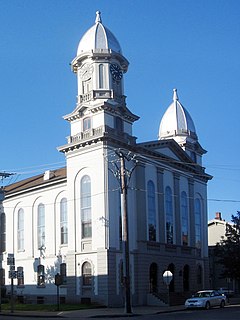
Lock Haven is the county seat of Clinton County, in the U.S. state of Pennsylvania. Located near the confluence of the West Branch Susquehanna River and Bald Eagle Creek, it is the principal city of the Lock Haven Micropolitan Statistical Area, itself part of the Williamsport–Lock Haven combined statistical area. At the 2010 census, Lock Haven's population was 9,772.

A campfire is a fire at a campsite that provides light and warmth, and heat for cooking. It can also serve as a beacon, and an insect and predator deterrent. Established campgrounds often provide a stone or steel fire ring for safety. Campfires are a popular feature of camping. At summer camps, the word campfire often refers to an event at which there is a fire. Some camps refer to the fire itself as a campfire.
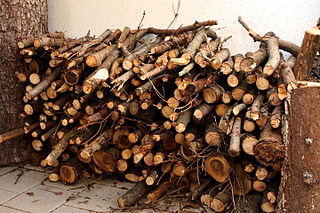
Firewood is any wooden material that is gathered and used for fuel. Generally, firewood is not highly processed and is in some sort of recognizable log or branch form, compared to other forms of wood fuel like pellets or chips. Firewood can be seasoned (dry) or unseasoned (fresh/wet). It is generally classified as hardwood or softwood.
In computer science, patience sorting is a sorting algorithm inspired by, and named after, the card game patience. A variant of the algorithm efficiently computes the length of a longest increasing subsequence in a given array.

Fort McIntosh was an early American log frontier fort situated near the confluence of the Ohio River and the Beaver River in what is now Beaver, Pennsylvania.

Key Marco was an archaeological site (8CR48) consisting of a large shell works island next to Marco Island, Florida. A small pond on Key Marco, now known as the "Court of the Pile Dwellers," (8CR49) was excavated in 1896 by the Smithsonian Institution's Pepper-Hearst Expedition, led by Frank Hamilton Cushing. Cushing recovered more than 1,000 wooden artifacts from the pond, the largest number of wooden artifacts from any prehistoric archaeological site in the eastern United States. These artifacts are described as some of the finest prehistoric Native American art in North America. The Key Marco materials are principally divided between the University of Pennsylvania Museum of Archaeology and Anthropology, University of Pennsylvania; the Department of Anthropology, National Museum of Natural History, Smithsonian Institution; and the Florida Museum of Natural History, University of Florida. The original pond was completely excavated and refilled. It is now covered by a housing subdivision. Excavations of small parts of the site were also conducted in 1965 and 1995..

Bucking is the process of cutting a felled and delimbed tree into logs. This can be a complicated process because logs destined for plywood, lumber, and pulp each have their own price and specifications for length, diameter, and defects. Significant value can be lost by sub-optimal bucking. Cutting from the top down is overbucking and from the bottom up is underbucking.

The University of Pennsylvania Press is a university press affiliated with the University of Pennsylvania located in Philadelphia, Pennsylvania.
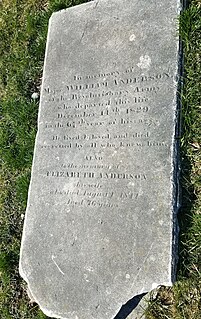
William Anderson was a member of the U.S. House of Representatives from Pennsylvania.

George Gray Leiper was a Jacksonian member of the U.S. House of Representatives from Pennsylvania.
Crosshole sonic logging (CSL) is a method to verify the structural integrity of drilled shafts and other concrete piles.

A log splitter is a piece of machinery or equipment used for splitting firewood from softwood or hardwood logs that have been pre-cut into sections (rounds), usually by chainsaw or on a saw bench. Many log splitters consist of a hydraulic or electrical rod and piston assembly and these are often rated by the tons of force they can generate. The higher the force rating, the greater the thickness or length of the rounds that can be split. The log splitter consists of all four major hydraulic components.
Laurentius Carels (1624–1688) was one of the first settlers of Delaware County, Pennsylvania and one of the first Swedish Lutheran clergyman in New Sweden. As was typical among Swedish ministers, he generally used a Latinized version of his name Laurentius Caroli Lockenius. He is listed in historical records under several different names, most commonly as Lars Carlsson Lock.

Stephenson–Campbell House, also known as the Stephenson–Campbell Property and the Stephenson Log House, is a historic site in Cecil, Pennsylvania containing four contributing buildings. Included are a 1778 log house, a 1929 Sears and Roebuck Company mail order bungalow style house, a 1929 spring house, and a 1928 garage. The log house is 16 feet by 34 feet, with several additions totaling about 1360 square feet. The log house is one of the few pre-1780 log houses still standing in Western Pennsylvania, and the only known example of a single story private home still extant in the area.
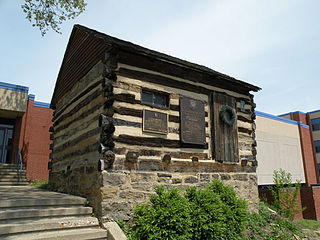
John McMillan's Log School is a landmark log building in Canonsburg, Pennsylvania that was the site of John McMillan's frontier latin school during the 1780s. It is a symbol of Canonsburg and Canonsburg's educational tradition. In 1930, The Pittsburgh Press said that the building was "viewed by the pioneers with even more reverence than Pittsburgh now view the towering Cathedral of Learning in Oakland." It is one of the oldest buildings in Western Pennsylvania. It is the "oldest educational building west of the Allegheny Mountains."
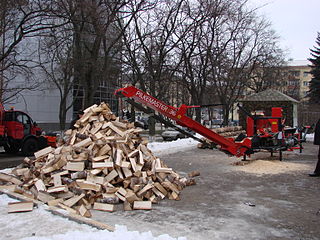
A firewood processor is a machine designed to cut and split firewood with minimal manual handling of the logs. There are typically four main parts of the machine, each dedicated to a separate function. Processing begins with a log pile – a pile of logs that have been de-limbed and cut to an appropriate length, generally 10–12 feet (3.0–3.7 m). Popular brands include Hakki Pilke, Wood Beaver, DYNA, Multitek and Blockbuster. Many individuals use processors commercially and also privately as a hobby. Others choose to rent them as an alternative to purchasing.

The Ljubljana Marshes, located south of Ljubljana, the capital of Slovenia, is the largest marsh in the country. It covers 163 square kilometres (63 sq mi) or 0.8% of the Slovene territory. It is administered by the municipalities of Borovnica, Brezovica, Ljubljana, Ig, Log-Dragomer, Škofljica and Vrhnika.

"The Hardwood Pile" is a contemporary fantasy story by American writer L. Sprague de Camp. It was first published in the magazine Unknown for September, 1940. It first appeared in book form in the collection The Reluctant Shaman and Other Fantastic Tales ; it later appeared in the collection The Best of L. Sprague de Camp, and the anthology Bestiary! The story has been translated into French and German.



















